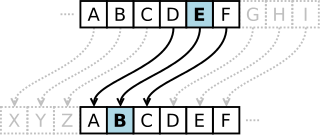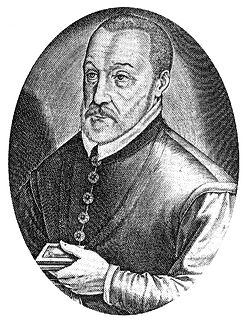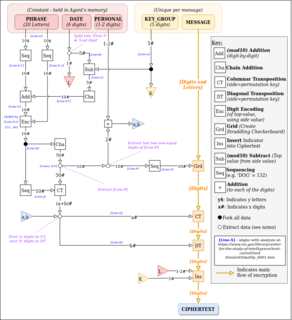Description
To encrypt a message, the agent would select words from the poem as the key. Every poem code message commenced with an indicator group of five letters, whose position in the alphabet indicated which five words of an agent's poem would be used to encrypt the message. For instance, suppose the poem is the first stanza of Jabberwocky:
’Twas brillig, and the slithy toves
Did gyre and gimble in the wabe:
All mimsy were the borogoves,
And the mome raths outgrabe.
We could select the five words THE WABE TOVES TWAS MOME, which are at positions 4, 13, 6, 1, and 21 in the poem, and describe them with the corresponding indicator group DMFAU.
The five words are written sequentially, and their letters numbered to create a transposition key to encrypt a message. Numbering proceeds by first numbering the A's in the five words starting with 1, then continuing with the B's, then the C's, and so on; any absent letters are simply skipped. In our example of THE WABE TOVES TWAS MOME, the two A's are numbered 1, 2; the B is numbered 3; there are no C's or D's; the four E's are numbered 4, 5, 6, 7; there are no G's; the H is numbered 8; and so on through the alphabet. This results in a transposition key of 15 8 4, 19 1 3 5, 16 11 18 6 13, 17 20 2 14, 9 12 10 7.
This defines a permutation which is used for encryption. First, the plaintext message is written in the rows of a grid that has as many columns as the transposition key is long. Then the columns are read out in the order given by the transposition key. For example, the plaintext "THE OPERATION TO DEMOLISH THE BUNKER IS TOMORROW AT ELEVEN RENDEZVOUS AT SIX AT FARMER JACQUES" would be written on grid paper, along with the transposition key numbers, like this:
15 8 4 19 1 3 5 16 11 18 6 13 17 20 2 14 9 12 10 7 T H E O P E R A T I O N T O D E M O L I S H T H E B U N K E R I S T O M O R R O W A T E L E V E N R E N D E Z V O U S A T S I X A T F A R M E R J A C Q U E S X
The columns would then be read out in the order specified by the transposition key numbers:
PELA DOZC EBET ETTI RUVF OREE IOAX HHAS MOOU LRSS TKNR ORUE NINR EMVQ TSWT ANEA TSDJ IERM OHEX OTEA
The indicator group (DMFAU) would then be prepended, resulting in this ciphertext:
DMFAU PELAD OZCEB ETETT IRUVF OREEI OAXHH ASMOO ULRSS TKNRO RUENI NREMV QTSWT ANEAT SDJIE RMOHE XOTEA
In most uses of code poems, this process of selecting an indicator group and transposing the text would be repeated once (double transposition) to further scramble the letters. As an additional security measure, the agent would add prearranged errors into the text as security checks. For example, there might be an intentional error in every 18th letter to ensure that, if the agent was captured or the poem was found, the enemy might transmit without the security checks.
Development
When Leo Marks was appointed codes officer of the Special Operations Executive (SOE) in London during World War II, he very quickly recognized the weakness of the technique, and the consequent damage to agents and to their organizations on the Continent, and began to press for changes. Eventually, the SOE began using original compositions (thus not in any published collection of poems from any poet) to give added protection (see The Life That I Have , an example). Frequently, the poems were humorous or overtly sexual to make them memorable ("Is de Gaulle's prick//Twelve inches thick//Can it rise//To the size//Of a proud flag-pole//And does the sun shine//From his arse-hole?"). Another improvement was to use a new poem for each message, where the poem was written on fabric rather than memorized.
Gradually the SOE replaced the poem code with more secure methods. Worked-out Keys (WOKs) was the first major improvement – an invention of Marks. WOKs are pre-arranged transposition keys given to the agents and which made the poem unnecessary. Each message would be encrypted on one key, which was written on special silk. The key was disposed of, by tearing a piece off the silk, when the message was sent.
A project of Marks, named by him "Operation Gift-Horse", was a deception scheme aimed to disguise the more secure WOK code traffic as poem code traffic, so that German cryptographers would think "Gift-Horsed" messages were easier to break than they actually were. This was done by adding false duplicate indicator groups to WOK-keys, to give the appearance that an agent had repeated the use of certain words of their code poem. The aim of Gift Horse was to waste the enemy's time, and was deployed prior to D-Day, when code traffic increased dramatically.
The poem code was ultimately replaced with the one-time pad, specifically the letter one-time pad (LOP). In LOP, the agent was provided with a string of letters and a substitution square. The plaintext was written under the string on the pad. The pairs of letters in each column (such as P,L) indicated a unique letter on the square (Q). The pad was never reused while the substitution square could be reused without loss of security. This enabled rapid and secure encoding of messages.

In cryptography, a cipher is an algorithm for performing encryption or decryption—a series of well-defined steps that can be followed as a procedure. An alternative, less common term is encipherment. To encipher or encode is to convert information into cipher or code. In common parlance, "cipher" is synonymous with "code", as they are both a set of steps that encrypt a message; however, the concepts are distinct in cryptography, especially classical cryptography.

In cryptography, encryption is the process of encoding information. This process converts the original representation of the information, known as plaintext, into an alternative form known as ciphertext. Ideally, only authorized parties can decipher a ciphertext back to plaintext and access the original information. Encryption does not itself prevent interference but denies the intelligible content to a would-be interceptor.

In cryptography, the one-time pad (OTP) is an encryption technique that cannot be cracked, but requires the use of a single-use pre-shared key that is no smaller than the message being sent. In this technique, a plaintext is paired with a random secret key. Then, each bit or character of the plaintext is encrypted by combining it with the corresponding bit or character from the pad using modular addition.
In cryptography, a substitution cipher is a method of encrypting in which units of plaintext are replaced with the ciphertext, in a defined manner, with the help of a key; the "units" may be single letters, pairs of letters, triplets of letters, mixtures of the above, and so forth. The receiver deciphers the text by performing the inverse substitution process to extract the original message.
In cryptography, a transposition cipher is a method of encryption by which the positions held by units of plaintext are shifted according to a regular system, so that the ciphertext constitutes a permutation of the plaintext. That is, the order of the units is changed. Mathematically a bijective function is used on the characters' positions to encrypt and an inverse function to decrypt.

In cryptography, a Caesar cipher, also known as Caesar's cipher, the shift cipher, Caesar's code or Caesar shift, is one of the simplest and most widely known encryption techniques. It is a type of substitution cipher in which each letter in the plaintext is replaced by a letter some fixed number of positions down the alphabet. For example, with a left shift of 3, D would be replaced by A, E would become B, and so on. The method is named after Julius Caesar, who used it in his private correspondence.
A chosen-plaintext attack (CPA) is an attack model for cryptanalysis which presumes that the attacker can obtain the ciphertexts for arbitrary plaintexts. The goal of the attack is to gain information that reduces the security of the encryption scheme.

The Vigenère cipher is a method of encrypting alphabetic text by using a series of interwoven Caesar ciphers, based on the letters of a keyword. It employs a form of polyalphabetic substitution.
In cryptography, a block cipher mode of operation is an algorithm that uses a block cipher to provide information security such as confidentiality or authenticity. A block cipher by itself is only suitable for the secure cryptographic transformation of one fixed-length group of bits called a block. A mode of operation describes how to repeatedly apply a cipher's single-block operation to securely transform amounts of data larger than a block.

In cryptography, ciphertext or cyphertext is the result of encryption performed on plaintext using an algorithm, called a cipher. Ciphertext is also known as encrypted or encoded information because it contains a form of the original plaintext that is unreadable by a human or computer without the proper cipher to decrypt it. This process prevents the loss of sensitive information via hacking. Decryption, the inverse of encryption, is the process of turning ciphertext into readable plaintext. Ciphertext is not to be confused with codetext because the latter is a result of a code, not a cipher.

The VIC cipher was a pencil and paper cipher used by the Soviet spy Reino Häyhänen, codenamed "VICTOR".
The affine cipher is a type of monoalphabetic substitution cipher, where each letter in an alphabet is mapped to its numeric equivalent, encrypted using a simple mathematical function, and converted back to a letter. The formula used means that each letter encrypts to one other letter, and back again, meaning the cipher is essentially a standard substitution cipher with a rule governing which letter goes to which. As such, it has the weaknesses of all substitution ciphers. Each letter is enciphered with the function (ax + b) mod 26, where b is the magnitude of the shift.
In cryptography, padding is any of a number of distinct practices which all include adding data to the beginning, middle, or end of a message prior to encryption. In classical cryptography, padding may include adding nonsense phrases to a message to obscure the fact that many messages end in predictable ways, e.g. sincerely yours.
In cryptography, a classical cipher is a type of cipher that was used historically but for the most part, has fallen into disuse. In contrast to modern cryptographic algorithms, most classical ciphers can be practically computed and solved by hand. However, they are also usually very simple to break with modern technology. The term includes the simple systems used since Greek and Roman times, the elaborate Renaissance ciphers, World War II cryptography such as the Enigma machine and beyond.

In cryptology, a code is a method used to encrypt a message that operates at the level of meaning; that is, words or phrases are converted into something else. A code might transform "change" into "CVGDK" or "cocktail lounge". The U.S. National Security Agency defined a code as "A substitution cryptosystem in which the plaintext elements are primarily words, phrases, or sentences, and the code equivalents typically consist of letters or digits in otherwise meaningless combinations of identical length." A codebook is needed to encrypt, and decrypt the phrases or words.
Multiple encryption is the process of encrypting an already encrypted message one or more times, either using the same or a different algorithm. It is also known as cascade encryption, cascade ciphering, multiple encryption, and superencipherment. Superencryption refers to the outer-level encryption of a multiple encryption.
The rail fence cipher is a form of classical transposition cipher. It derives its name from the manner in which encryption is performed.
Authenticated encryption (AE) and authenticated encryption with associated data (AEAD) are forms of encryption which simultaneously assure the confidentiality and authenticity of data.
In the history of cryptography, a grille cipher was a technique for encrypting a plaintext by writing it onto a sheet of paper through a pierced sheet. The earliest known description is due to the polymath Girolamo Cardano in 1550. His proposal was for a rectangular stencil allowing single letters, syllables, or words to be written, then later read, through its various apertures. The written fragments of the plaintext could be further disguised by filling the gaps between the fragments with anodyne words or letters. This variant is also an example of steganography, as are many of the grille ciphers.

Cryptography, or cryptology, is the practice and study of techniques for secure communication in the presence of adversarial behavior. More generally, cryptography is about constructing and analyzing protocols that prevent third parties or the public from reading private messages; various aspects in information security such as data confidentiality, data integrity, authentication, and non-repudiation are central to modern cryptography. Modern cryptography exists at the intersection of the disciplines of mathematics, computer science, electrical engineering, communication science, and physics. Applications of cryptography include electronic commerce, chip-based payment cards, digital currencies, computer passwords, and military communications.








